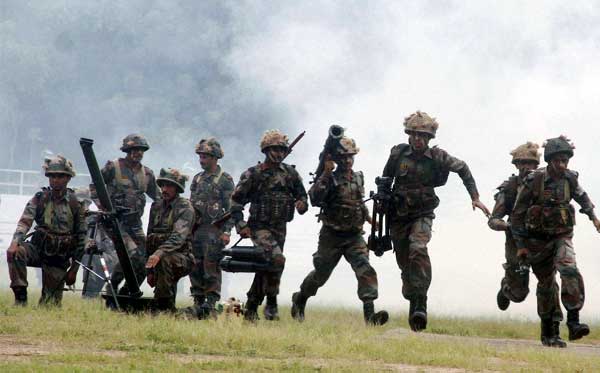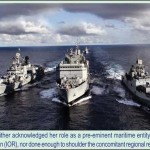
Speaking during the Kargil Diwas celebrations, Prime Minister Narendra Modi on July 27 called upon the Army, Navy and Air Force to better integrate themselves as they modernize their capabilities, and said that the Armed Forces should also strive towards “jointness” despite “wearing different uniforms. He also added that government is taking several measures to speed up military modernization. He warned Pakistan for its nefarious designs and said, “Pakistan did not expect such a powerful response in Kargil”, adding that the time had come for a united global effort to deal with countries resorting to proxy war and terrorism as instruments of state policy.
Where are the national security strategy and the strategic defence review to enable drawing up requisite joint operational plans? MoD remains exclusively manned by generalist bureaucrats. Why has HQ IDS not been merged with MoD?
Modi said the nature of war is fast-changing, with space and cyberspace becoming the new frontiers of warfare, and government has shown its commitment to national security despite international pressure by operationalizing its nuclear submarine INS Arihant and successfully testing an anti-satellite interceptor missile to destroy a satellite in March this year.
This year being the 20th Anniversary of Kargil Conflict., some of the above would likely be part of the Prime Minister’s speech from the ramparts of Red Fort on August 15, much to the applause of the audiences present and those watching TV channels.
It may be recalled that chairing the first Combined Commanders Conference on board INS Vikramaditya on December 15, 2015 during his first tenure as Prime Minister, Modi had emphasized amongst other issues, “We should promote jointness across every level of our Armed Forces. We wear different colours, but we serve the same cause and bear the same flag. Jointness at the top is a need that is long overdue. Senior military leaders must have experience of tri-service commands, experience in technology-driven environment and exposure to the full spectrum of challenges – from terrorism to strategic. We need military commanders who not only lead brilliantly in the field, but are also thought leaders who guide our forces and security systems into the future. We should learn from the experience of the others, but we must frame our systems and commands on our own genius.”
Going back to 2004, then Prime Minister Manmohan Singh addressing the Combined Commanders Conference had said, “Reforms within the Armed Forces involve recognition of the fact that our Navy, Air Forces and Army can no longer function in compartments with exclusive chains of command and single service operational plans.”
What Manmohan Singh said in 2004, what Modi said in 2015 and repeated on July 27 is all very good for rhetoric and exciting for voters with short memories, but can someone explain how are the Army, Navy and Air Force supposed to better integrate themselves? Surely this can’t happen when the political authority has shown zero inclination towards ‘executing’ military integration?
Where are the national security strategy and the strategic defence review to enable drawing up requisite joint operational plans? The Ministry of Defence (MoD) remains exclusively manned by generalist bureaucrats. Why has HQ IDS not been merged with MoD? Is it fear of disturbing the goose that lays the golden eggs? There was much propaganda about lateral inductions at joint secretary level but MoD remains untouched.
Do we need two power centres under the same man? Is this an example of ‘minimum government, maximum governance’, with little to talk about defence reforms?
The Kargil Review Committee and follow up Group of Ministers had recommended early establishment of Chief of Defence Staff. Pranab Mukherjee as Defence Minister and later Manohar Parrikar hinted CDS was round the corner. Now there are indications government may appoint a Permanent Chairman COSC (PC COSC) at some point of time in future, who anyway will have no operational powers less out of area contingencies.
NSA, Ajit Doval (already 74 years and six months of age), who is not answerable to Parliament, has been elevated to Cabinet Minister’s rank and is heading both the Strategic Policy Group (SPG) and the Defence Planning Committee (DPC), both of which have large number of common members. Do we need two power centres under the same man? Is this an example of ‘minimum government, maximum governance’, with little to talk about defence reforms?
Why is the DPC working on a national security strategy, when the NSAB has reportedly evolved one sometime back? Is it merely to put the seal of NSA on the new document? Will Prime Minister Modi acknowledge that without a CDS is the key to military integration and true revolution in military affairs (RMA), or will India continue with the de-facto CDS in the NSA, and MoD in present shape, with the political authority dependent on bureaucratic advice, and bureaucrats holding all the aces?
Despite HQ IDS having ordered and analyzed five studies on Theatre Commands in 2005-2006, which were agreed at DGMO and equivalent level benefiting all three services. Yet there is no inclination by MoD to follow these up. How long will we continue the farce of calling upon the military to integrate themselves?
The battlefield of tomorrow requires Effect Based Operations (EBOs). EBOs can best be progressed through application of all the instruments of the nation state. What this implies is that EBO can only succeed if all components of national power are brought to bear, which in turn means that Defence Forces must have full spectrum joint operations capability and an integrated approach. It is also important to understand that this synergistic application of power is to be applied at all levels of warfare, be it tactical, operational or strategic. For those who feel that HQ IDS is providing necessary jointness, anyone who has served in HQ IDS will vouch that the organization is sans powers to enforce jointness in the Services, of which there are numerous examples.
Military jointness is an imperative, not luxury. Yet the government remains unconcerned beyond periodic rhetoric. MoD continues to follow the ‘divide and rule policy’ and selection of the PC COSC, as and when, will probably be based on ‘political affiliation-inclination and quality of ‘exceptional pliability’; including whoever contributed most in relegating military below BSF, CRPF, ITBP, SSB, even Railway Protection Force.
Despite the Pakistani treachery and the vast expanse and depth of enemy intrusions, wasn’t it stupid for our government to impose restrictions that the LoC would not be crossed at any cost?
The Kargil anniversary is remembered annually and the homage must be paid to martyrs but have we addressed the negatives? India rightfully went to the International Court of Justice (ICJ) in the case of Kulbhushan Jadhav held by Pakistan. But can we hide our shame that we did not bother to approach the ICJ for the inhuman torture and killing of Captain Saurabh Kalia and his entire patrol, of which physical evidence was available.
Despite the Pakistani treachery and the vast expanse and depth of enemy intrusions, wasn’t it stupid for our government to impose restrictions that the LoC would not be crossed at any cost? Our Special Forces, who could have eliminated the main enemy gun position at Ghyari, were instead used for direct assault on enemy positions because of this restriction. Not many would be aware that there was no American pressure on us to not cross the LoC. So what stopped us from at least removing enemy observation over Dras-Kargil section of Srinagar-Leh National Highway (NH 1-D), considering China illegally occupied 38,000 sq km of Aksai Chin (Indian Territory) to provide depth to its Western Highway.
Didn’t our Parliament pass a resolution in 1994 that Kashmir is integral to India? If we could call Pakistan’s nuclear bluff in 2019 in attacking Balakot, why couldn’t we do so 20 years back, especially when Pakistan didn’t have its nuke delivery mechanism complete.
Prime Minister Modi has announced that India attaining a $5 trillion is very much feasible. So, why are we not addressing the ‘hollowness’ of Armed Forces? Economy of a nation dictates the size and reach of Armed Forces. Ad hoc acquisition of weapon systems and poor defence allocations are hardly the answer. Arbitrary reduction of manpower without ‘physical fielding’ of compensatory technological force multipliers, when we are not even manning the LAC against China in adequate strength at all times, and lack of an overall strategy construct with a minister now quipping that Army could be employed in the Maoists belt, does appear naïve. Wonder if this minister is aware that in Chhatisgarh alone there are over 60 battalions of a mix of CAPF deployed today, which equal some five and a half Infantry Divisions of the Army?
The fact remains there is enough money in India, much of which is misutilized. This is one major reason why the RTI Act is being diluted so that no questions can be asked. Continuing to harp on pay and pensions is not going to lead us anywhere. It is a question of whether the government is interested to establish a strong military capability or not. Military modernization continues to remain a casualty, which is also in public domain.
In 2015, Modi had said, “Ours is a difficult neighbourhood with the full spectrum of security challenges….. We know that old rivalries can play out in new theatres such as space and cyber….. We must fully incorporate the power of digital networks and space assets into our capabilities. Equally, we must be prepared to defend them, for they will be the first targets of our adversaries”.
US turnaround on Pakistan and Taliban takeover of Afghanistan should be wake-up calls, ignoring which will be stupid.
On July 27 this year, Modi has again emphasized space and cyberspace becoming new frontiers of warfare. However, while acknowledging the full spectrum security challenges, he only talked of the need for united global effort to deal with proxy war and terrorism. This is sidetracking the strategic asymmetry we have in terms of sub-conventional capability vis-à-vis China and Pakistan, while hoping for foreign powers to deal with our problems. Short-distance cross-border raids and Balakot-type airstrikes are no remedy for this, no matter the propaganda.
US turnaround on Pakistan and Taliban takeover of Afghanistan should be wakeup calls, ignoring which will be stupid. If we are really looking at becoming a major economic power, we cannot be safe without full spectrum military muscle, including in terms of sub-conventional capacity.





This is some plain talking. Prior to this the articles appearing in IDR seemed to always allude to Modi Govt being the panacea for all the ills of the country including the defences issues. This article indicates that in India the political hue of the Govt is immaterial. All Governments are a self serving tools for the politicians.